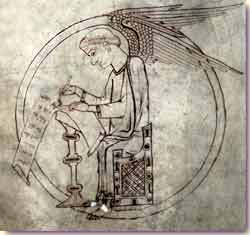From the Thorley
Archives
Thorley's Domesday
Record
In 1086 William the Conqueror dispatched civil
servants throughout England to assess who owned what and how much
each parish was worth. Details were set out as a register on
sheepskin pages. The survey sheets were completed according to a
strict questionnaire similar to our present day ten yearly census.
William's initial survey took only seven months to complete.
Judging by the handwriting, a single monastic clerk was then
responsible for copying out all these sheets. As this was
information that was to form the basis for a system of taxation,
it had to be verified by a jury of four Frenchmen and four
Englishmen from each district. The audit was also used by William
I to confirm which of his knights and bishops had acquired land,
how much it was worth and how many fighting men he could call
upon in the event of an invasion from Scandinavia.

|
Monastic clerk writing on parchment
|
So sophisticated was its organisation and so
all embracing its implications for landowners, with no appeal,
that they likened it to the Last Day of Judgement or Domesday.
The actual record for Thorley can be seen in
the following photograph.

An annotated translation of this record is as
follows.
Geoffrey
de Mandeville
- a leading Norman Baron.
Sometimes known as
Geoffrey de Magnaville
|
|
|
Thorley
known as
Torlei in 1086
|
|
1 hide
= approx 120 acres
used for tax assessment
|
|
Geoffrey
holds Thorley himself.
It answers for 4 hides. Land for
8 ploughs.
In lordship 2 hides; 4 ploughs
there.
5 villagers,
a man-at-arms and a priest
and 9 smallholders have 3½
ploughs;
a further ½ possible. 11 slaves.
1 mill at 10s; meadow
for 2 ploughs;
woodland, 40 pigs;
pasture for the livestock.
Total value £8;
when acquired 100s;
before 1066 £10.
Godith, Asgar the Constable's
man,
held this manor; he could sell.
William, Bishop of London, bought this manor
from King William with Godith's consent;
the Bishop of London now claims
it.
|
|
1 plough
assumed to
mean a team of 8 oxen
|
|
lordship of
Thorley Manor
|
|
villagers
were male land owning peasants
|
|
a man-at-arms
was a peasant
eligible for military service
|
|
a
priest confirms the
existence of the church
|
|
smallholders were
peasants
owning smaller plots of land
|
|
a slave
was a male or
female landless peasant
|
|
|
10s was
the annual rent paid
to the Manor
|
|
common hay meadows
near
the River Stort
|
|
woodland
was measured
by the number of pigs
it could support
|
|
Asgar
was a high ranking soldier in
King Edward's Army
|
|
Value of Thorley Manor:
at the time of the 1086 Domesday Survey = £8
when the Norman Lord acquired it = 100s
= £5
before the Norman Conquest in 1066 = £10
|
|
Evidence of a disputed claim
to Thorley Manor
|
|
Other local entries in the Victorian County
History provide interesting comparisons. Bishop's Stortford -
which takes its name from ownership by the Norman Bishop of
London - is recorded as having only 6 hides, 10 ploughs, 6
villagers, a priest, two men at arms and two mills worth 30
shillings. Sawbridgeworth was the major town of importance at
this period. It's significant entry details 24½ hides, 40
ploughs, 50 villagers, 2 priests, one mill, meadow for 20 plough
teams and woodland for 300 pigs. Geoffrey de Mandeville (alternatively
recorded as Magnaville) was also the major landowner in
Sawbridgeworth, and Thorley kept its close manorial ties with
this settlement up to the 1700s.
Bill Hardy
June 2004
From the
Archives